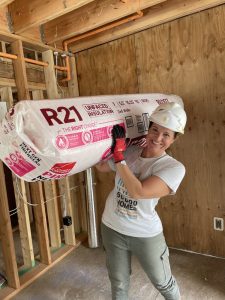Volume 16, Issue 3
 CEO update: Home is Where We Heal
CEO update: Home is Where We Heal
By Suzanne Anarde-Devenport, RCAC Chief Executive Officer
Several years ago, I spoke at the Hawaiian housing conference. I had a bit of an outline for my remarks, but as I sat in the audience listening to other speakers and their messages, it struck me that the word that was resounding for me as the overarching value of having a home was the word “heal.” I opened my remarks with the phrase “Home is Where We Heal” and framed the remainder of my remarks around that concept. Afterward, my Native Hawaiian friend Robin Danner came up to me with tears in her eyes and shared that she had not ever heard home described in that manner. She said it spoke to her heart, as it had mine. As we celebrate National Homeownership month in June, I am reminded of that phrase….
PN 583 makes significant changes to HB-1-3550 Chapters 4, 6 & 10
By Angela Sisco, RCAC RDS – Housing III
On June 2, 2023 U.S. Department of Agriculture Rural Development (USDA RD) issued PN 583. This seven-page PN makes significant changes to HB-1-3550 Chapters 4, 6 and 10 and to several handbook letters. Changes and clarifications have been made to income, credit, assets, determining repayment ability, other eligibility requirements, issuing the Certificate of Eligibility, updates to underwriting guidance related to refinance loans, allowable loan terms, and the annual loan quality review requirements and more! RCAC has gone through the changes and identified the new language (changes or clarification) and made comments where appropriate….
Read more about the changes
A Message from the USDA Rural Development Self-Help Program Manager, Branch Chief, Andria Hively
 Hello Self-Help housing enthusiasts from across the nation! I became involved with the Self-Help Program 18 years ago as a Loan Approval Official for USDA – Rural Development in Washington State. I had one Self-Help grantee in my service area and my favorite part of my job was move-in day for the families. Now, I oversee the Self-Help Program’s regulations, funding, T&MA Regional Contracts, and 83 active grantees nationwide, and my favorite part of my job is still attending a key ceremony on move-in day. There is absolutely no other program like Self-Help, and you all are the ones making it happen. Thank you for being a part of this special program, and for helping us ensure its success.
Hello Self-Help housing enthusiasts from across the nation! I became involved with the Self-Help Program 18 years ago as a Loan Approval Official for USDA – Rural Development in Washington State. I had one Self-Help grantee in my service area and my favorite part of my job was move-in day for the families. Now, I oversee the Self-Help Program’s regulations, funding, T&MA Regional Contracts, and 83 active grantees nationwide, and my favorite part of my job is still attending a key ceremony on move-in day. There is absolutely no other program like Self-Help, and you all are the ones making it happen. Thank you for being a part of this special program, and for helping us ensure its success.
The COVID-19 pandemic hit the world hard, as it did our beloved Self-Help Program. Supply shortages, skyrocketing material costs, and social distancing increased build times and for many of you caused delays in progressing your program’s grant goals. Thankfully, in Fiscal Year 2022, the program received $4 million in disaster assistance. With these funds, we were able to support many organizations with cost extensions to allow more time for you to meet your grant goals. With the ending of the national emergency and the exhausting of the disaster funds, the temporary program flexibilities are ending.
It is time to move the Self-Help Program back to its strengths, building and repairing houses throughout rural communities. Meeting the Self-Help Program goals to achieve a successful grant rating is key to the stability of the program. Building and rehabilitating homes at the lowest cost possible is vital to assisting as many low- and very low-income rural citizens as possible. We are all in the critical business of providing affordable homeownership, and together we will continue to make the Self-Help Program an important part of that mission. I can’t wait to see what you will accomplish. Thank you for partnering with us in the Self-Help Program!
RCAC Self-Help shares training videos
By Anne Baker, RCAC RDS – Housing
Are you new to SHARES or do you have a quick question about SHARES data entry? Good news! We have now added pre-recorded SHARES Trainings videos to the growing library of videos on the RCAC website. Currently our library includes 5 Days of 502 for Self-Help Loan Packaging found in the SH Trainings and Webinars tab as well as additional videos that can be found within the SH Financial Tool Kit tab. Here you will find SHARES training videos for each section of SHARES. These include Access and Main Page, Grant Module (File), Borrower Module (File), Quarterly Reporting, Entity Module. You’ll now be able to watch, rewatch, fast forward and rewind these smaller bite sized videos any time you would like. You can find all these resources here.
If you still need assistance or have questions about SHARES you can contact your SHARES Technical Resource Coordinators, Nancy Jacobsen and Anne Baker at shares@rcac.org.
New 38 year mortgage term usage guidance
As has always been the requirement, for the borrower to be eligible for an exception to the standard 33-year term (i.e., 38 years) the borrower’s adjusted income can’t exceed 60% of adjusted AMI. If the 4-A Worksheet for Computing Income reflects a ‘Yes’, this simply means the calculator recognizes the applicant’s adjusted income is less than 60% of adjusted AMI. However, this does not mean that the 38-year term should automatically be used when determining eligibility, it just indicates it may be considered because the applicant is less than 60% of adjusted AMI.
If the applicant isn’t eligible using standard terms, or the loan doesn’t appear feasible, first consider other compensating factors, as discussed in Par. 4.24 A., not resulting in multiple risk layering.
If the loan still doesn’t appear feasible and the 4-A worksheet indicates ‘yes’, they are eligible for a 38-year term, then recompute the loan using a 38-year term. For example, if an applicant is below 60% of the adjusted AMI and doesn’t qualify for the established minimum area loan limit using standard terms, and other compensating factors were considered or not applicable, then you should consider recalculating the loan amount at 38 years.
In summary, the key change is that the 38-year term should not be an automatic at COE, simply because the applicant is below 60% of adjusted AMI. Other factors as noted earlier must be considered when determining if the 38-year term is appropriate.
Dear Sher,
Read the answer from Dear SherDear Sher,
I just want to make sure I am understanding this correctly. Based on new PN 583, when completing the 4-A Worksheet for Computing Income, do I need to exclude the revolving accounts from it? See the new handbook language below. I’m working with a family that has several revolving accounts that are working on paying them off in a couple of months. As of now they are not eligible as the revolving accounts are making their TDR high but if I don’t count the revolving accounts then their TDR will be within eligibility. Below is what I read, please advise.
Long-term installment obligations with more than 10 months repayment remaining, including loans, alimony, and child support (including back child support payments), but excluding revolving accounts. Funds borrowed from a retirement account are excluded since the applicant is repaying a loan to themselves. In the event an applicant does not repay the loan as agreed, the debt is reported as taxable income during that tax year but will be treated as sporadic income. All medical debts (be it a collection, judgment, etc.) are excluded.
Sincerely,
PN583 and Revolving Accounts
Homeownership to Increase Racial & Wealth Initiative
By Gina Chamberlain, RCAC Homeownership Program Manager
Through the Homeownership to Increase Racial and Wealth Equity (HIRWE) initiative, RCAC will offer training, technical assistance, and resources to our existing and potential partners. The goal is to increase access to affordable homeownership for Indigenous households and households of color by building local capacity with our participating partners.
This three-year initiative includes training, technical assistance, and small pass-through grants to support, create or expand your program to meet affordable homeownership needs of households of color and Indigenous households in RCAC’s 13-state region. This initiative will also be developing resources to assist in the local need for down payment assistance for low and very-low-income homebuyers. This initiative will increase homeowners of color and Indigenous homeowners, so some resources will only be available for those that work in communities with a higher diverse population, and who demonstrate a commitment to collect and report data on program results. However, we will provide additional training resources to all with a shared commitment to making affordable homeownership a tool to address the racial wealth gap. Contact Gina Chamberlain, Homeownership Program Manager, (360) 968-3045, gchamberlain@rcac.org for more information and a HIRWE Participant Application.
News You Can Use!
Centralized Section 523 (Re)application Forms
By Anne Baker, RCAC RDS – Housing
In the past it could be difficult to find the appropriate form to use for 523 Grant applications and the post award forms required for reporting and follow up. Many forms that are used in the grant application are the responsibility of another agency and therefore are found among that agency’s forms requiring the grantee to search for the forms they need. Recently USDA RD has added all of the grant application and post award forms in one central place for easy access. These can now quickly be found on USDA RD’s Mutual Self-Help Housing Technical Assistance Grants page of their website in the “To Apply” tab that can be found at Mutual Self-Help Housing Technical Assistance Grants | Rural Development (usda.gov). This new availability makes it easy to find all of the forms you need in one place.
RCAC Homeownership Program
RCAC’s Homeownership Program assists rural communities in addressing their affordable homeownership needs for new and existing low and very-low-income homeowners. We don’t provide direct assistance to homeowners; however, we work with local nonprofits and agencies who are assisting individuals in rural communities in RCAC’s region. With a staff of three, all with local nonprofit experience in USDA 502 Direct packaging and housing counseling, we provide training, technical assistance, the 502 Direct Intermediary application review, and administer the Homeownership to Increase Racial and Wealth Equity Initiative (HIRWE). Since we started in 2022, we have focused on outreach to new areas, and capacity building both internally and with our local partners. We have also retooled our 502 Intermediary review process including a new online application submission which is being implemented this summer.
We strive to develop the needed resources identified by our local partners, which in the coming year will include training for ownership rehabilitation and developing down payment assistance resources. The staff has restructured and includes state leads and a subject matter focus to better assist our local partners. We welcome 523 self-help grantees to partner in homeownership areas beyond your 523 program. Contact Gina Chamberlain, Homeownership Program Manager, (360) 968-3045, gchamberlain@rcac.org to participate or for additional information.
The newsletter is published quarterly for the western region self-help network at no cost to subscribers.
We encourage correspondence and contributions.
Chief Executive Officer: Suzanne Anarde Devenport
Executive Editor: Angela Sisco, asisco@rcac.org
Managing Editor: Dawn Van Dyke, dvandyke@rcac.org
Editorial office, West Sacramento, CA (916) 447-2854
Stay updated. Stay informed. Join the newsletter >>
